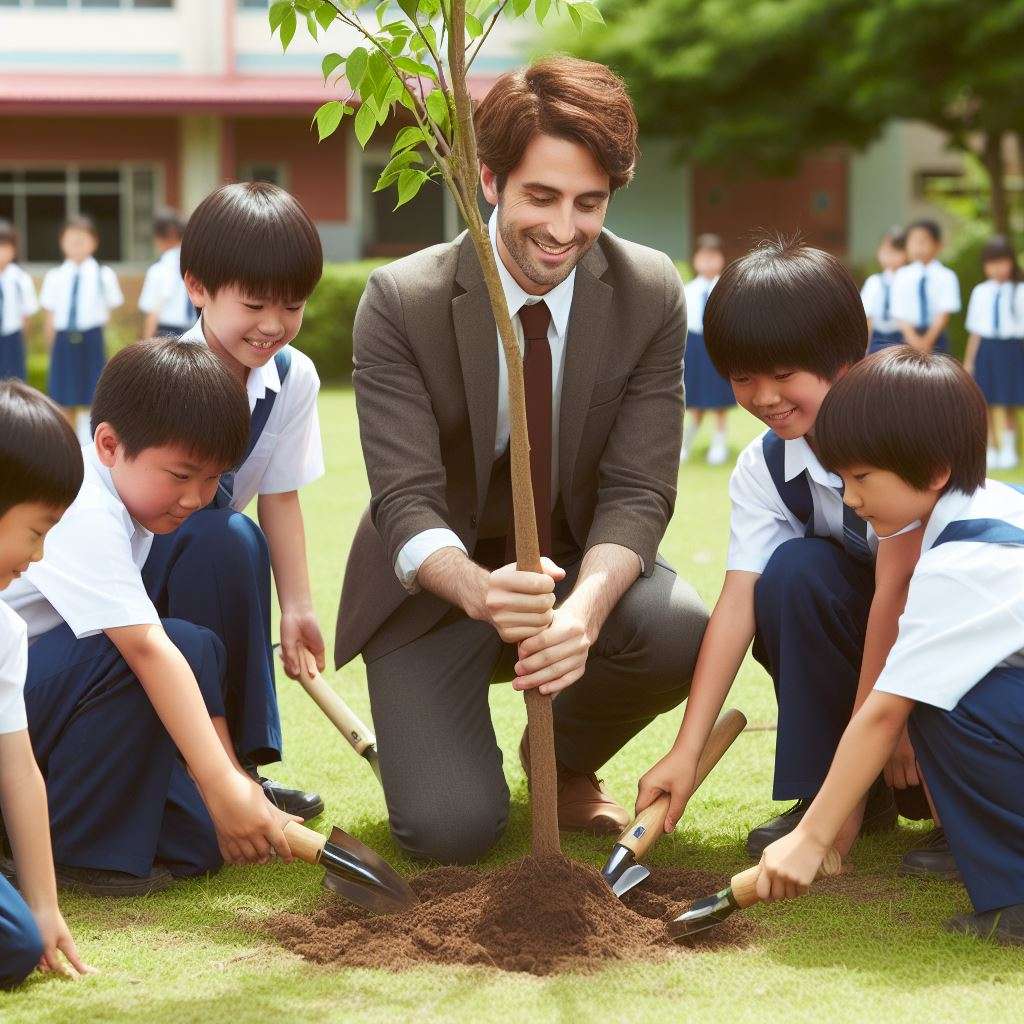“We are the first generation to feel the effect of climate change and the last generation who can do something about it.” – Barack Obama
The world is facing unprecedented environmental challenges that threaten the survival of life on Earth. Climate change, biodiversity loss, and pollution are some of the most pressing issues that require urgent action. The world urgently needs a new generation of informed citizens and active stewards to address these challenges and create a more sustainable and just world.
The Grim Reality of our Planet
Climate Change
Climate change is the result of human activities that increase the concentration of greenhouse gases in the atmosphere, causing the Earth to warm up. According to the Intergovernmental Panel on Climate Change (IPCC), the global average temperature has risen by about 1.1°C since the pre-industrial era and is projected to rise by 1.5°C to 4.5°C by the end of the century, depending on the emission scenarios.
The consequences of climate change are already evident and devastating. Some of the impacts include:
- Extreme weather events, such as heat waves, droughts, floods, storms, and wildfires, cause deaths, displacements, and damage to infrastructure and livelihoods.
- Rising sea levels, due to the melting of glaciers and ice sheets, threaten the existence of low-lying islands and coastal communities.
- Loss of biodiversity, as many species struggle to adapt to the changing climate and habitats.
- Food insecurity, as crop yields and fish stocks decline due to changing weather patterns and water availability.
- Human health risks, as climate change increases the exposure to vector-borne diseases, malnutrition, heat stress, and mental stress.
Biodiversity Loss
Biodiversity refers to the variety and abundance of life on Earth, including genes, species, and ecosystems. Biodiversity is essential for the functioning of the biosphere, as it provides ecosystem services, such as pollination, nutrient cycling, water purification, and climate regulation, that support human well-being.
However, biodiversity is declining at an alarming rate, due to human activities that destroy and degrade natural habitats, such as deforestation, urbanization, agriculture, mining, and overexploitation. According to the Living Planet Report 2020, the global population sizes of mammals, birds, amphibians, reptiles, and fish have declined by 68% on average between 1970 and 2016.
The loss of biodiversity has serious implications for the stability and resilience of ecosystems, as well as the provision of ecosystem services. Some of the impacts include:
- Reduced crop diversity and productivity, as pollinators, soil organisms, and pest controllers decline.
- Increased vulnerability to invasive species, diseases, and pests, as native species and natural defenses are weakened.
- Reduced carbon sequestration and storage, as forests, wetlands, and other carbon-rich ecosystems are degraded or converted.
- Loss of cultural and aesthetic values, as many species and landscapes have spiritual, recreational, and educational significance.

Pollution
Pollution is the introduction of harmful substances or energy into the environment, such as chemicals, metals, plastics, noise, and radiation, that cause adverse effects on living organisms and natural systems. Pollution is mainly caused by human activities, such as industrial production, transportation, energy generation, and waste disposal. According to the Global Burden of Disease Study 2019, pollution is responsible for 9 million premature deaths per year, or 16% of all deaths worldwide.
The impact of pollution on human health and the environment is enormous and multifaceted. Some of the impacts include:
- Respiratory and cardiovascular diseases, cancers, and neurological disorders, as air pollution affects the lungs, heart, brain, and other organs.
- Waterborne diseases, such as cholera, typhoid, and dysentery, as water pollution contaminates drinking water sources and aquatic ecosystems.
- Soil degradation, reduced crop yields, and food contamination, as soil pollution alters the soil chemistry, biology, and structure.
- Marine debris, entanglement, ingestion, and toxicity, such as plastic pollution, accumulate in the oceans and affect marine life.
- Global warming, ozone depletion, and acid rain, as greenhouse gases, aerosols, and other pollutants affect the climate and the atmosphere.
The following image shows the smog over Delhi, India, one of the most polluted cities in the world, which causes severe health problems and reduced visibility:

Why We Need Change Agents
Inadequacy of the current approach
The current approach to addressing the environmental challenges is inadequate and ineffective. Despite the existence of various international agreements, national policies, and local initiatives, the environmental problems continue to worsen and the solutions remain insufficient. Some of the reasons for the inadequacy of the current approach include:
- Lack of political will and commitment, as many governments prioritize short-term economic interests over long-term environmental goals.
- Lack of public awareness and participation, as many people are unaware of the causes and consequences of the environmental problems, or lack the motivation and means to take action.
- Lack of coordination and cooperation, as many stakeholders have conflicting interests and agendas, or fail to communicate and collaborate effectively.
- Lack of innovation and adaptation, as many solutions are outdated, inappropriate, or unsustainable, or fail to address the root causes and systemic factors of the problems.
The power of individuals
The power of individuals to make a difference in the environmental challenges is immense and undeniable. Collective action fueled by informed and motivated citizens can create positive change and influence the decision-making processes at various levels. Some of the ways that individuals can contribute to the environmental solutions include:
- Reducing their environmental footprint, by adopting more sustainable lifestyles and consumption patterns, such as using renewable energy, saving water, recycling waste, and choosing green products.
- Raising their environmental voice, by expressing their opinions and demands, participating in public consultations and campaigns, and holding the authorities and corporations accountable.
- Supporting environmental causes, by donating money or time, joining or forming environmental organizations, and engaging in advocacy and activism.
- Learning and sharing environmental knowledge, by educating themselves and others, accessing and disseminating reliable information, and fostering dialogue and debate.
Shifting mindsets and behaviors
The need for a generation that views environmental stewardship as a core value and responsibility is paramount and urgent. Shifting mindsets and behaviors is the key to achieving lasting and meaningful change in the environmental challenges. Some of the aspects of the mindset and behavior shift include:
- Developing a sense of connection and appreciation for nature, by recognizing the intrinsic value and interdependence of all living beings, and the benefits and services that nature provides.
- Adopting a holistic and systemic perspective, by understanding the complexity and interrelatedness of the environmental problems, and the multiple dimensions and implications of the solutions.
- Embracing a proactive and positive attitude, by taking initiative and responsibility, seeking opportunities and solutions, and celebrating achievements and successes.
- Cultivating a critical and ethical awareness, by questioning and challenging the status quo, the dominant paradigms, and the vested interests, and by considering the equity and justice implications of the environmental problems and solutions.
Educators: Shaping the Future Stewards
The crucial role of educators
Educators play a crucial role in shaping the future stewards of the environment. Educators have the power and the responsibility to inculcate environmental knowledge, foster critical thinking, and inspire action in young minds. Educators can influence the cognitive, affective, and behavioral domains of their students, by:
- Providing accurate and relevant information, facts, and concepts about the environmental problems and solutions, and their causes and consequences.
- Developing analytical and evaluative skills, such as problem-solving, decision-making, and evidence-based reasoning, that enable students to understand and address the environmental challenges.
- Stimulating emotional and motivational responses, such as curiosity, empathy, and passion, that encourage students to care about and engage with the environmental issues.
- Modeling and facilitating positive and constructive actions, such as personal and social actions, that empower students to take action and make a difference in the environmental challenges.
Moving beyond textbooks
Moving beyond textbooks is essential for effective and engaging environmental education. Textbooks are often limited, outdated, or biased in their coverage and presentation of the environmental topics. Embracing experiential learning, connecting students with nature, and promoting hands-on projects are some of the ways to enhance environmental education. These approaches can:

- Increase the relevance and applicability of the environmental knowledge, by linking it to the real-world contexts, situations, and experiences.
- Enhance the interest and enjoyment of the environmental learning, by making it more interactive, fun, and meaningful.
- Foster the connection and appreciation for nature, by exposing students to the beauty and diversity of natural environments, and the challenges and threats they face.
- Encourage the action and participation in the environmental solutions, by providing opportunities for students to apply their knowledge and skills, and to contribute to real and tangible projects.
Examples of transformative education
There are many examples of transformative education that demonstrate the potential and impact of environmental education. School gardens, composting initiatives, and sustainability campaigns led by students are some of the examples that can:
- Promote environmental literacy and awareness, by teaching students about the natural cycles, the sources and impacts of waste, and the principles and practices of sustainability.
- Develop environmental skills and competencies, by involving students in planning, designing, implementing, and maintaining the projects, and by using various tools and methods to monitor and evaluate the outcomes.
- Inspire environmental values and attitudes, by cultivating a sense of responsibility, ownership, and pride in the projects, and by fostering a sense of community, collaboration, and empowerment among the students and other stakeholders.
- Facilitate environmental action and change, by creating visible and positive results, such as improved aesthetics, increased biodiversity, reduced waste, and enhanced well-being, and by influencing the behavior and policies of the school and the wider community.
The following image shows a school garden project in Kenya, where students learn about organic farming, nutrition, and environmental conservation, while producing food for themselves and their families:
A Call to Action:
Empowering educators
Empowering educators is vital for enhancing and expanding environmental education. Educators need resources, training, and support to integrate environmental education into their curriculum and pedagogy. Some of the ways to empower educators include:
- Providing access to quality and updated materials, such as textbooks, manuals, guides, and online platforms, that cover the environmental topics and issues in a comprehensive and engaging way.
- Offering professional development opportunities, such as workshops, courses, webinars, and networks, that enhance the environmental knowledge and skills of educators, and provide them with best practices and examples of environmental education.
- Creating a conducive and supportive environment, such as policies, incentives, recognition, and feedback, that encourage and enable educators to implement environmental education in their classrooms and schools.
Engaging students
Engaging students is crucial for motivating and involving them in environmental education. Students need to be active and participatory learners, who explore, discover, and create their own environmental understanding and action. Some of the ways to engage students include:
- Providing choice and voice, such as allowing students to select their own topics, methods, and projects, and to express their own opinions, ideas, and solutions.
- Making learning relevant and meaningful, such as connecting the environmental issues to the students’ lives, interests, and values, and showing the impact and significance of their actions.
- Fostering collaboration and interaction, such as facilitating group work, peer learning, and dialogue among students, and with other stakeholders, such as experts, community members, and policymakers.
Building a collective effort
Building a collective effort is essential for creating a supportive and synergistic environment for environmental education. Parents, communities, and policymakers need to work together to create a culture and a system that values and promotes environmental education. Some of the ways to build a collective effort include:
- Raising awareness and advocacy, such as informing and persuading the public and the authorities about the importance and benefits of environmental education, and the challenges and opportunities it faces.
- Establishing partnerships and alliances, such as forming and joining networks, coalitions, and platforms, that bring together different actors and sectors, and leverage their resources and expertise.
- Coordinating and aligning actions and policies, such as developing and implementing common goals, strategies, and standards, that ensure the coherence and effectiveness of environmental education.
Conclusion:
Hope for the future: The potential for a new generation of environmental champions to create a more sustainable and just world.
The environmental challenges that the world faces are daunting and complex, but not insurmountable. There is hope for the future if we act now and act together. Environmental education is a powerful and promising tool to shape the future stewards of the environment, who will have the knowledge, skills, values, and actions to address the environmental challenges and create a more sustainable and just world.

A symbol of hope and positive change, like a group of students planting trees or celebrating a successful environmental project.
